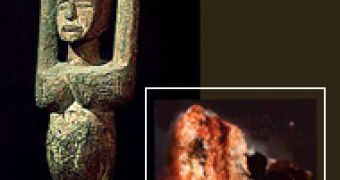Many ancient African or American rites involved blood sacrifices. But finding proofs of this in the ancient artifacts is not that easy. And what about a paint based on blood? Now, a new technology allowed a French team to show the existence of blood from ritual animal sacrifice in the paint of ancient sculptures coming from the Mali empire (early 13th century to late 15th century), as revealed in an issue of Analytical Chemistry. Anthropological and ethnological data showed, based on oral traditions and images, that ancient African artists often employed ritual animal blood as a means of pleasing their gods.
The investigated sculptures were made by Dogon people, whose decorated or painted artifacts were supposed to have used various pigments partly made of blood, but due to the artifacts' age, and the mixed composition of the patina, standard chemical analyses were useless.
That's why the team at the Center for Research and Restoration of the Museums of France in Paris, collaborating with mass-spectroscopy specialists at the French National Research Agency in Gif-sur-Yvette and the European Synchrotron Radiation Facility in Grenoble, employed two types of mass spectroscopy and two of x-ray scanning.
"The techniques are so sensitive that they can detect even a few target molecules in a few micro grams of material", said co-author Pascale Richardin, physical chemist.
The techniques were also complementary, so that one targeted molecule missed by one technique could be detected by the others. The analysis showed undoubtedly the presence in the patina of a type of iron strongly connected to blood.
"The research shows without doubt that the wooden figures were used in ceremonies involving animal sacrifice", said electro analytical chemist Christian Amatore of the ?cole Normale Sup?rieure in Paris.
"Next up is analyzing the painting materials used by the masters of the European Renaissance - not to look for blood, but to attempt to reveal the secrets of their colors and textures", said Richardin.

 14 DAY TRIAL //
14 DAY TRIAL //